Quick-Start
The Quick-Start guide explains how to, in few steps, get from an API to a functional Unreal Engine plugin.
1. Install the Code Generator
ApiGear provides two powerful tools: a Studio and a Command Line Interface (CLI). The Studio is a graphical tool for creating, editing API modules and projects, while the CLI is a command-line tool for generating code from API modules. Both offer comprehensive functionality, including SDK template management, API project creation, code generation, API monitoring, and API simulation.
Install ApiGear Studio
ApiGear Studio is available for macOS, Windows, and Linux. You can download it from the ApiGear Studio GitHub releases page.
For more detailed information on ApiGear Studio, refer to the dedicated studio documentation.
Install ApiGear CLI
The ApiGear CLI is a versatile command-line tool for generating code from API modules. It's available for macOS, Windows, and Linux. Download the latest version from the ApiGear CLI GitHub releases page.
The CLI offers all the features available in the Studio.
For more detailed information on the ApiGear CLI, consult the dedicated CLI documentation.
2. Obtain the Template
There are several methods to obtain the template: installation via the Studio, installation via the CLI, or cloning/downloading from GitHub.
The ApiGear Studio and the CLI detect the specified template in the solution document and install it automatically.
Optional steps (click to expand)
Installation via CLI
When using the CLI, only the highlighted line needs to be executed. You can verify the successful installation using the template cache command.
- Unreal Engine
- C++14
- Qt6
- Python
$ apigear template install apigear-io/template-unreal@v3.2.2
$ apigear template cache
list of templates from the local cache
source | url | installed | latest
apigear-io/template-unreal@v3.2.2 | https://github.com/apigear-io/template-unreal.git | <sha1> | v3.2.2
...
$ apigear template install apigear-io/template-cpp14@v3.6.0
$ apigear template cache
list of templates from the local cache
source | url | installed | latest
apigear-io/template-cpp14@v3.6.0 | https://github.com/apigear-io/template-cpp14.git | <sha1> | v3.6.0
...
$ apigear template install apigear-io/template-qtcpp@v0.4.0
$ apigear template cache
list of templates from the local cache
source | url | installed | latest
apigear-io/template-qtcpp@v0.4.0 | https://github.com/apigear-io/template-qtcpp.git | <sha1> | v0.4.0
...
$ apigear template install apigear-io/template-python@v1.0.0
$ apigear template cache
list of templates from the local cache
source | url | installed | latest
apigear-io/template-python@v1.0.0 | https://github.com/apigear-io/template-python.git | <sha1> | v1.0.0
...
Installation via Studio
Installing the template through the Studio is straightforward:
- Unreal Engine
- C++14
- Qt6
- Python
- Open an existing project or create a new one
- Navigate to the
Templatestab - Click
Installon theapigear-io/template-unrealentry
- Open an existing project or create a new one
- Navigate to the
Templatestab - Click
Installon theapigear-io/template-cpp14entry
- Open an existing project or create a new one
- Navigate to the
Templatestab - Click
Installon theapigear-io/template-qtcppentry
- Open an existing project or create a new one
- Navigate to the
Templatestab - Click
Installon theapigear-io/template-pythonentry
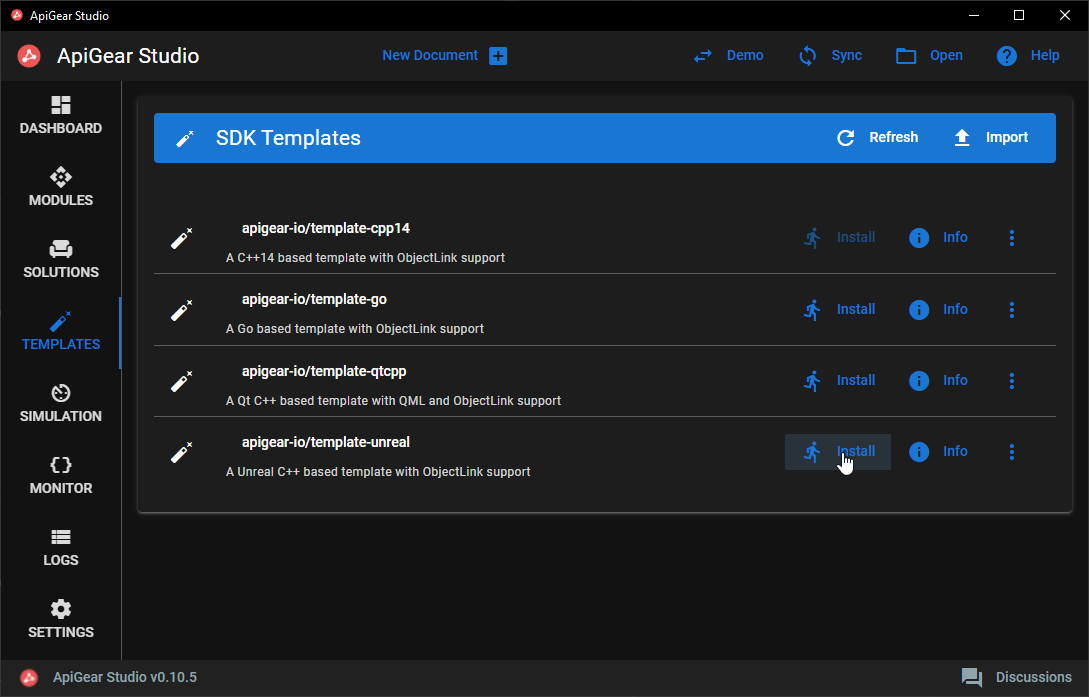
Cloning from GitHub
If you need to inspect or modify the template's source code, cloning or downloading the repository is recommended. The repository doesn't need to be part of your project and can be stored anywhere on your computer.
- Unreal Engine
- C++14
- Qt6
- Python
$ git clone https://github.com/apigear-io/template-unreal.git
$ git clone https://github.com/apigear-io/template-cpp14.git
$ git clone https://github.com/apigear-io/template-qtcpp.git
$ git clone https://github.com/apigear-io/template-python.git
You can then configure the solution file to use your template by providing the relative path from the solution file to the template directory.
3. Set Up the Project
A typical project requires two files: a solution file specifying the APIs and the template to use, and at least one API module file. Ideally, both should be placed in a folder named apigear, adjacent to each other.
Alternatively, you can use the Studio to create a new project and modify the two example files provided.
Solution File
Create a solution file. The example below specifies:
- Module files in line 8, here the
helloworld.module.yamlmodule with theHelloAPI - The output directory for generated files in line 9
- The template used to generate the code in line 10 (this can also be a path to a local copy of the template)
- The enabled features of the template in line 13, here the
stubsfeature, which provides a simple implementation of interfaces.
- Unreal Engine
- C++14
- Qt6
- Python
schema: "apigear.solution/1.0"
name: hello_world_example
version: "0.1.0"
targets:
- name: ue_docs
inputs:
- helloworld.module.yaml
output: ../ue_docs
template: apigear-io/template-unreal@v3.2.2
force: true
features:
- stubs
schema: "apigear.solution/1.0"
name: hello_world_example
version: "0.1.0"
targets:
- name: cpp_hello_world
inputs:
- helloworld.module.yaml
output: ../cpp_hello_world
template: apigear-io/template-cpp14@v3.6.0
force: true
features:
- stubs
schema: "apigear.solution/1.0"
name: hello_world_example
version: "0.1.0"
targets:
- name: qt_hello_world
inputs:
- helloworld.module.yaml
output: ../qt_hello_world
template: apigear-io/template-qtcpp@v0.4.0
force: true
features:
- stubs
schema: "apigear.solution/1.0"
name: hello_world_example
version: "0.1.0"
targets:
- name: hello_world
inputs:
- helloworld.module.yaml
output: ../py_hello_world
template: apigear-io/template-python@v1.0.0
force: true
features:
- stubs
You can extend this solution file with additional targets, each for a different technology with a different template. The module.yaml file is technology-independent and can be used with any template.
We highly recommend specifying the exact version of the template. Otherwise, a newer version will be automatically downloaded and used for code generation. This can lead to unexpected behavior if file structures or code changes in the template.
Set the force parameter to true if you want to always override all generated files. When set to false, some files, such as implementations (stub feature), won't be updated. API files are always updated regardless of this setting.
API Module File
Use your preferred text editor to create the helloworld.module.yaml file with the following example content:
schema: apigear.module/1.0
name: io.world
version: "1.0.0"
interfaces:
- name: Hello
properties:
- { name: last, type: Message }
operations:
- name: say
params:
- { name: msg, type: Message }
- { name: when, type: When }
return:
type: int
signals:
- name: justSaid
params:
- { name: msg, type: Message }
enums:
- name: When
members:
- { name: Now, value: 0 }
- { name: Soon, value: 1 }
- { name: Never, value: 2 }
structs:
- name: Message
fields:
- { name: content, type: string }
4. Generate Code
Generate via CLI
The following snippet demonstrates how to run the CLI and provides an example output:
$ apigear generate solution apigear/helloworld.solution.yaml
10:52:20 INF generated 21 files in 30ms. (20 write, 0 skip, 1 copy) topic=gen
- The
generatecommand instructs the CLI to generate code - The
solutionparameter specifies that we want to process a solution file
Generate via Studio
- Open the project
- Navigate to the
Solutionstab - Click
Runon thehelloworld.solution.yamlentry
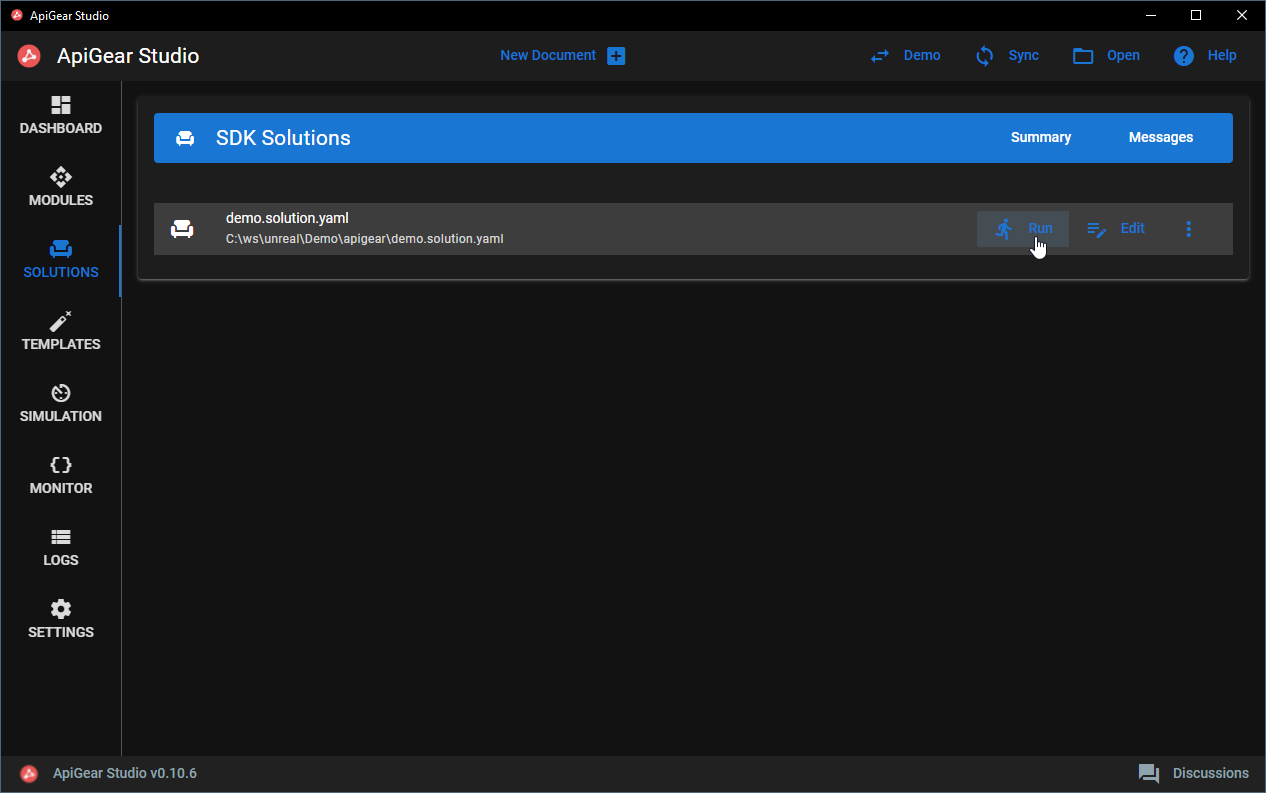
5. How to use the plugin
Project folder structure
For the code generation we assume that both ApiGear files reside in an apigear subfolder next to the Unreal Engine project.
In this case the folder structure should look similar to this.
📦ue_docs_example_project
┣ 📂apigear
┃ ┣ 📜helloworld.solution.yaml
┃ ┗ 📜helloworld.module.yaml
┣ 📂ue_docs
┃ ┣ 📂Config
┃ ┣ 📂Content
┃ ┣ 📂Platforms
┃ ┣ 📂Plugins
┃ ┣ 📂Source
┃ ┗ 📜ue_docs.uproject
Using the the solution file from the previous paragraph the code will be generated in the ue_docs/Plugins folder.
The generated code can be used with Blueprints and C++. The following paragraphs show how this can be achieved. Make sure to have the generated plugin code in your projects plugins directory as noted in the previous section.
Blueprint
Open your project in the Unreal Editor and choose a Blueprint where you want to use the interface. In this Blueprint we first get the GameInstance subsystem of the type Io World Hello.
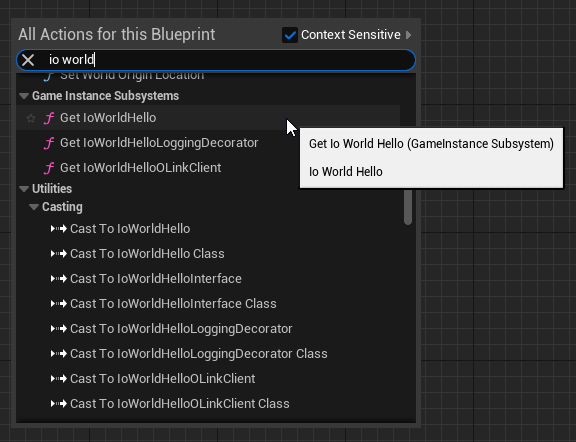
On this subsystem we can choose the asynchronous say function.
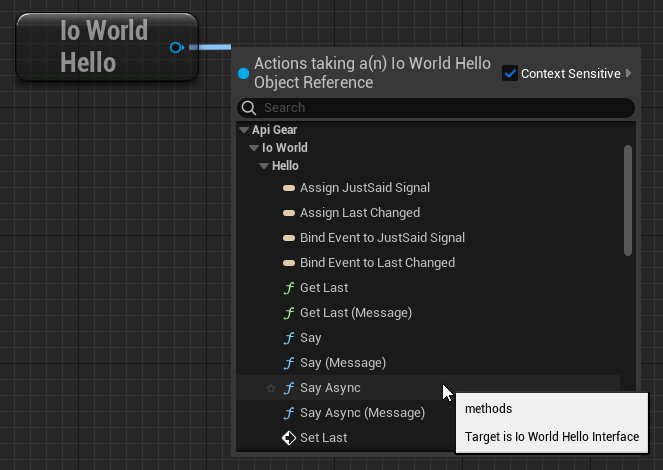
The complete setup to say "Hello world" on begin play.
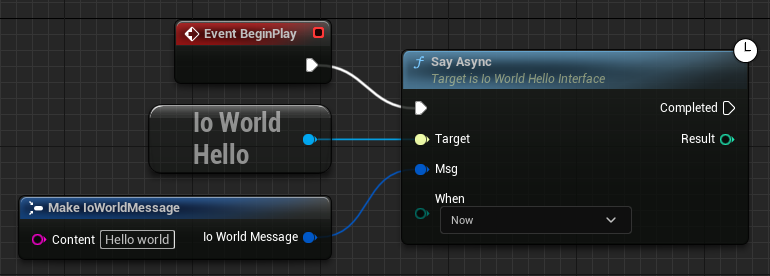
C++
Since the generated interface is used outside of its own module, we have to add the module identifier to the list of dependency modules in the dependent module e.g. your project's or another plugin's module.
To do this, open the dependents module, e.g. ue_docs.Build.cs, and add IoWorld to the PublicDependencyModuleNames. IoWorld is the demo module's name in the example.
PublicDependencyModuleNames.AddRange(new string[] { "Core", "CoreUObject", "Engine", "InputCore", "IoWorld" });
Afterwards, we can simply include the header files for the api interface, the stub implementation and use it.
#include "ue_docsGameModeBase.h"
#include "Implementation/IoWorldHello.h"
#include "Generated/api/IoWorld_data.h"
#include "Generated/api/IoWorldHelloInterface.h"
void Aue_docsGameModeBase::InitGame(const FString& MapName, const FString& Options, FString& ErrorMessage)
{
Super::InitGame(MapName,Options, ErrorMessage);
TScriptInterface<IIoWorldHelloInterface> HelloWorldObjPtr = GetGameInstance()->GetSubsystem<UIoWorldHello>();
FIoWorldMessage MyMsg;
MyMsg.content = FString("Hello world");
HelloWorldObjPtr->Say(MyMsg, EIoWorldWhen::IWW_NOW);
}